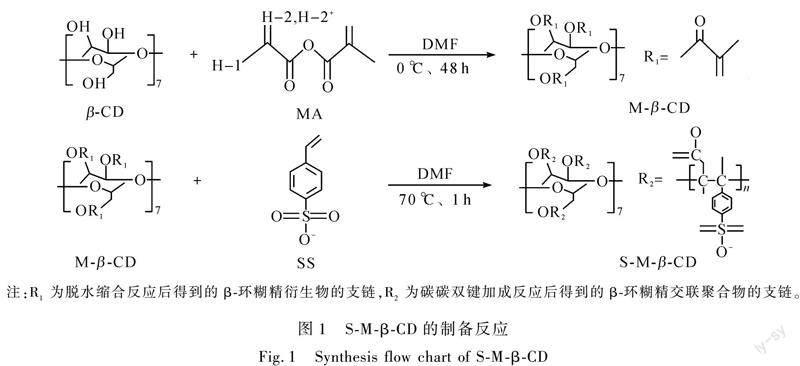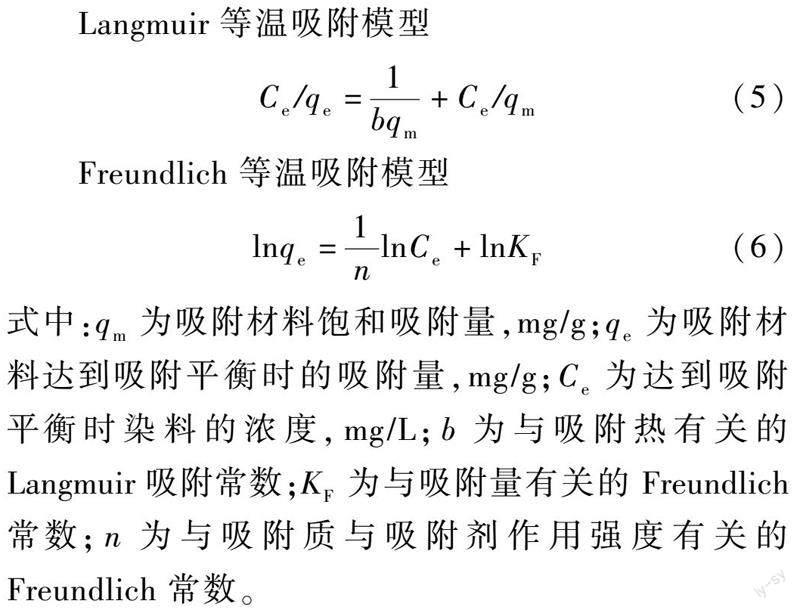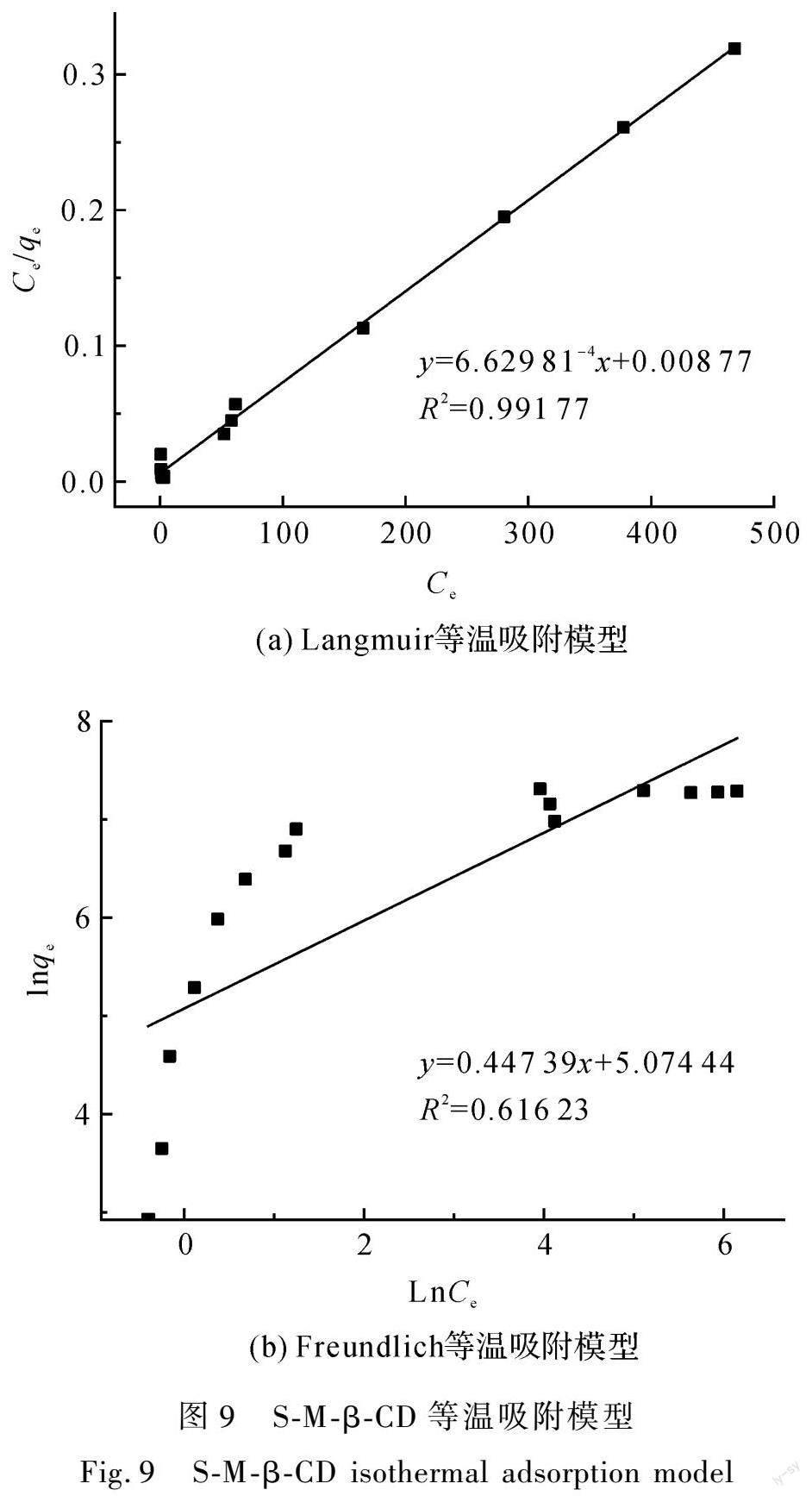β-环糊精多孔材料的制备及其模拟印染废水中亚甲基蓝的吸附性能
郝星 陈一航 李妮 马明波 刘银丽



摘 要:为了开发新型高效的吸附材料以实现对印染废水的高效处理,采用β-环糊精(β-CD)、甲基丙烯酸酐(MA)、对苯乙烯磺酸钠(SS)为原料,通过脱水缩合反应及碳碳双键加成反应制备含有磺酸基团(—SO3H)多孔结构的β-环糊精基交联聚合物(S-M-β-CD)。测试分析S-M-β-CD的微观结构特性以及对模拟印染废水中亚甲基蓝(MB)的吸附性能,结果表明:S-M-β-CD为表面粗糙的多孔纳米微球,表面富含羟基(—OH)和磺酸基团(—SO3H),可以为MB提供大量的结合位点。S-M-β-CD对亚甲基蓝(MB)的吸附过程符合拟二级吸附动力学模型和Langmuir等温吸附模型,对MB表现出良好的循环吸-脱附性,经7次循环吸-脱附后,S-M-β-CD对MB的吸附效率可达98.15%。S-M-β-CD作为新型吸附材料,对实现印染废水的低成本、高效处理具有重要意义。
关键词:β-环糊精;多孔材料;印染废水;吸附;循环
中图分类号:TS190.3
文献标志码:A
文章编号:1009-265X(2023)03-0172-10
基金项目:浙江省清洁实验室开放基金项目(QJRZ2112);浙江理工大学柯桥研究院培育项目(KYY2021001S);浙江理工大学科研启动基金项目(21202087-Y)
作者简介:郝星(1995—),男,安徽安庆人,硕士研究生,主要从事功能高分子材料方面的研究。
通信作者:刘银丽,E-mail: ylliu@zstu.edu.cn
纺织工业是众多资源与能源密集的行业之一,每年都会产生大量印染废水。印染废水排放量大、成分复杂、色素含量高,如何实现印染废水高效率、低成本处理一直是人们亟待解决的难题。相较于其他废水处理方法,吸附法因操作简单,吸附效率高,成本低廉而备受青睐,近年来被广泛应用于印染废水中污染物的去除。吸附法中的常用传统吸附材料有黏土、活性炭、蒙脱土、污泥等[1-2],但这些传统吸附材料对印染废水的去除效率低,且材料本身循环利用性差。随着国家对印染废水排放标准的提高,传统吸附材料的污染物去除性能很难达到废水处理要求,且循环再生性能差、耗能大,因此需要开发新的吸附材料。
近年来,β-环糊精(β-cyclodextrin, β-CD)作为吸附材料在印染废水处理的相关领域的应用越来越广泛,例如Yan等[3]合成了一种新型聚多巴胺和β-CD聚合物共修饰磁性氧化石墨烯复合吸附剂(PDA/MGO/CA-CD),用于吸附印染废水中亚甲基蓝(MB)、孔雀石绿(MG)和结晶紫(CV),结果显示对其染料的最大吸附量分别为1372.32、822.39 mg/g和570.79 mg/g,并且可以选择性地从阳离子/阴离子混合染料溶液中捕获阳离子染料。Wang等[4]利用羟基磷灰石/丙烯酰胺/β-CD成功了合成了一种水凝胶吸附剂,用于吸附水中的重金属离子和染料,结果表明,添加羟基磷灰石的水凝胶的抗压强度提高37.10%,吸附等温线模型表明最大吸附容量为300 mg/g。Ma等[5]采用静电纺丝法制备了平均纤维直径为167~174 nm的海藻酸钠(SA)/β-CD纳米纤维复合膜。SA/β-CD膜对亚甲基蓝的吸附量为2776 mg/g,可在较宽的pH范围内使用,并在4次循环后保持优异的吸附能力。其快速吸附效率和优异的吸附能力赋予了废水处理领域巨大的潜力,远高于纯SA膜的
吸附量(1780 mg/g)。β-CD是由葡萄糖分子以α-1,4糖苷键连接而成的环状低聚糖,具有天然无毒,廉价易得,生物可相容等特点,其外侧具有大量的羟基基团,可以被多种官能团修饰而得β-CD衍生物,内部特殊的空腔结构,可包络多种有机/无机污染物分子[6-7]。但β-CD特有的水溶性限制了它在印染废水处理中的应用,通常的解决策略是通过交联聚合反应或化学固载β-CD来形成不易溶于水的β-CD基吸附材料[8]。
本文以β-CD、甲基丙烯酸酐(Methacrylic anhydride,MA)、对苯乙烯磺酸钠(Sodium p-styrene sulfonate,SS)为原料,通过脱水缩合反应以及碳碳双键的加成反应制备出含有磺酸基团(—SO3H)的交联聚合物S-M-β-CD,深入研究S-M-β-CD的微观结构特性,系统分析S-M-β-CD对亚甲基蓝(Methylene blue,MB)的吸附机理。为β-CD类吸附材料在印染废水处理领域的应用提供更多的理论研究依据,同时也为开发低成本、高效率的新型吸附材料提供可行的研究方法。
1 实 验
1.1 实验原料
亚甲基蓝(MB,70%),β-环糊精(β-CD,98%),对苯乙烯磺酸钠(SS,98%)、过硫酸铵(APS,AR,98%)、三乙胺(TEA,AR,99%),甲基丙烯酸酐(MA,94%),N-N二甲基甲酰胺(DMF,AR,99.5%),均購于上海阿拉丁生化科技股份有限公司,且均未经纯化处理直接使用。
1.2 S-M-β-CD的制备
取5.0 g β-CD置于100 mL反应试剂瓶中,取50 mL DMF加入上述试剂瓶中,磁力搅拌至β-CD完全溶解,随后分别取5.0 g TEA和12.5 g MA依次加入上述混合溶液中。将混合溶液置于0 ℃冰浴环境下磁力搅拌48 h,随后将得到的反应混合溶液在去离子水中透析48 h,然后将得到的固体沉淀物真空干燥24 h,制得的淡黄色粉末状样品命名为M-β-CD。
取5.0 g M-β-CD和10.0 g SS置于50 mL DMF溶液中,充分搅拌至完全溶解。取5.0 g APS加入上述混合溶液中,70 ℃磁力搅拌1 h,将得到的固体沉淀物在去离子水中透析48 h,然后真空干燥24 h,制得的白色粉末状样品命名为S-M-β-CD,合成示意图如图1所示。
1.3 结构表征分析
1.3.1 傅里叶红外光谱(FTIR)测试
采用美国PerkinElmer公司的Antaris Ⅱ型傅里叶变换近红外光谱仪(FTIR)测试样品,波数测试范围为400~4000 cm-1。
1.3.2 核磁共振氢谱(1H NMR)和核磁共振碳谱(13C NMR)测试
采用德国Bruker公司的AVANCE400型核磁共振波谱仪测试样品,共振频率为400 MHz测试核磁共振氢谱(1H NMR)和碳谱(13C NMR)。其中,测试核磁共振氢谱(1H NMR)前取少量的样品充分溶解于氚代二甲基亚砜(C2D6OS)中。
1.3.3 扫描电子显微镜(SEM)测试
采用日本Hitachi公司的TM-3000型扫描电子显微镜测试分析不同磁力搅拌转速下(500、1000、1500、2000 r/min)的S-M-β-CD的表观形态,测试电压为3 kV。取适量样品经导电胶黏在电镜台上,之后将样品喷金60 s。
1.3.4 比表面积及孔径分析
采用美国Quantachrome 公司的Micromeritics ASAP 2020 V4 型全自动比表面积及孔径分析仪,利用BET法分析比表面积及孔径。
2 结果与讨论
2.1 结构性能表征
2.1.1 红外光谱分析
β-CD、MA和M-β-CD的红外光谱如图2(a)所示。对比β-CD、MA和M-β-CD的红外光谱可以看出,M-β-CD在3409、2928、1725、1159 cm-1处出现特征伸缩峰,分别对应于—OH、—CH2、CO、C—O的伸缩振动,在1632 cm-1出现CC的特征伸缩峰[9-11],M-β-CD保留了β-CD和MA中大部分特征基团,并产生了新的基团(酯基),说明通过β-CD和MA之间发生了脱水缩合反应,以上结果表明CC双键被成功地引入到M-β-CD中。
SS和S-M-β-CD的红外光谱如图2(b)所示,对比SS和S-M-β-CD的红外光谱可以看出,S-M-β-CD在3449、2928、1725、1658 cm-1处出现特征伸缩峰,分别对应于—OH、—CH2、CO、CC的伸缩振动,S-M-β-CD在1403、1190、1042、839、682、554 cm-1处具有和SS相同基团的特征峰[9-11],表明M-β-CD和SS发生了碳碳双键的加成反应,磺酸基团(—SO3H)被成功地引入到S-M-β-CD中。
2.1.2 核磁谱图分析
图3(a)-(c)分别为β-CD、MA和M-β-CD的1HNMR图谱。对比β-CD、MA和M-β-CD的1HNMR图谱可以看出,M-β-CD的1HNMR图谱在化学位移δ=1.89(H-8)、2.72(H-4)、2.89(H-2)、3.86(H-5)、4.05(H-3)、4.07(H-6)、4.91(H-1)、4.43(OH-6)、5.65(OH-3)、5.67(OH-2)、6.06(H-9)处出现特征峰。表明β-CD和MA发生了脱水缩合反应,M-β-CD保留了β-CD和MA和大部分特征基团,CC被成功引入到M-β-CD中[12-13]。
如图3(d)为S-M-β-CD的13CNMR图谱。S-M-β-CD的13CNMR图谱在化学位移δ=60.76(C-6)、71.93(C-2)、72.61(C-3)、73.98(C-5)、82.13(C-4)、102.42 (C-1)处的峰值对应β-CD的C的特征峰,在化学位移δ=141.5(C-7)、149.62(C-8)、150.13(C-9)、165.26(C-10)等峰值对应SS的C的特征峰,在化学位移δ=178.03(C-11)处的峰值对应M-β-CD中酯基上CO双键的C的特征峰,在化学位移δ=45.24(C-12)为新形成的C—C的特征峰,表明M-β-CD和SS发生了碳碳双键的加成反应,磺酸基团(SO3H)被成功地引入到S-M-β-CD中[12-13]。
2.1.3 微观形貌分析
通过SEM测试表征S-M-β-CD的形态特征。如图4所示,S-M-β-CD呈现为大小不一的球块形状,且表面粗糙凹凸不平、存在多孔隙。究其原因,β-CD特殊的空腔结构及SS上带有支链的磺酸基团(—SO3H)在反应中被排斥分布在微球表面,进而在S-M-β-CD表面形成凹凸不平的结构,促进其对MB的吸附。
2.1.4 比表面积和孔径分析
在77 K下对S-M-β-CD 进行氮气吸-脱附测试,以分析它们的比表面积和孔结构特征。在相对压力(P/Po)为0.85时氮气吸附量明显增加,这表明样品中存在中孔结构。由图5中的孔径分布图得知样品由大多数的介孔以及极少量的微孔构成,BET拟合后的方程计算得到的比表面积为2.3683 m2/g,平均孔径为31.9877 nm,平均孔体积为1.0164 cm3/g。以上结果表明S-M-β-CD是一种介孔类的吸附性材料,这有助于染料污染物的吸附。
2.2 S-M-β-CD对MB的吸附性能研究
取一定量的染料MB溶于去離子水中,配制MB浓度为500 mg/L的模拟印染废水母液。取一定量的MB母液,将其进行逐步稀释,配置浓度分别为50、100、200 mg/L的模拟印染废水溶液备用。分别配制浓度为0.1 mol/L的HCL和NaOH水溶液,用于调节模拟印染废水溶液的pH值。
取质量浓度为200 mg/L 20mL的模拟印染废水溶液,利用0.1 mol/L的HCL和NaOH水溶液将其pH值调节至1~12,用以研究模拟印染废水的pH值对S-M-β-CD吸附性能的影响。在常温下(25 ℃),将20 mg的S-M-β-CD浸入初始浓度为200 mg/L、20 mL的模拟印染废水溶液中,控制吸附时间分别为0、50、100、150 min,用以研究S-M-β-CD的吸附动力学,将S-M-β-CD分别浸入初始浓度为50、100、200 mg/L的模拟印染废水溶液中,常温平衡吸附24 h,用以研究S-M-β-CD的等温吸附。
采用美国Perkin-Elmer公司的UV/VIS Spectrometer Lambda 35型紫外分光光度计测试吸附前后模拟印染废水溶液中MB的浓度,并利用式(1)和式(2)定量表征S-M-β-CD的吸附性能[14-15]。
式中:C0为吸附前模拟印染废水中MB的浓度,mg/L;Ct为吸附时间t时模拟印染废水中MB的浓度,mg/L;Rt为吸附时间t时模拟印染废水中MB的去除效率;V为模拟印染废水体积,mL;m为S-M-β-CD的质量,mg;qt为吸附时间t时S-M-β-CD对MB的吸附量,mg/g。
2.2.1 pH值对吸附性能的影响
pH对MB去除效率的影响如图6所示,从图6可以看出,当模拟印染废水MB溶液的pH值由1增加到9时,S-M-β-CD对MB的吸附率在逐渐增加,最大吸附率接近于99%,且吸附前后MB溶液变化如图7所示;当模拟印染废水MB溶液的pH值由9增加到12时,S-M-β-CD对MB的吸附率在逐渐降低。究其原因,在低pH的MB溶液中存在大量的H+,其与MB竞争可用的活性吸附位点,同时S-M-β-CD中的磺酸基团(—SO3H)被质子化,导致与MB溶液中阳离子产生静电排斥,降低了S-M-β-CD的吸附能力[16-18]。随着pH的升高,质子化的程度逐渐降低,S-M-β-CD对MB的吸附率逐渐上升。当MB溶液在高浓度pH环境中,吸附率又逐渐下降,这是因为S-M-β-CD中的磺酸基团(—SO3H)被去质子化,S-M-β-CD与MB产生了静电斥力,使得对MB的吸附效率降低。同时在强碱性环境中大量的—OH不利于β-CD主体分子对客体MB的疏水包络而使包合常数K值低[19]。
2.2.2 S-M-β-CD吸附动力学
图8为S-M-β-CD对MB的吸附动力学曲线。为了研究S-M-β-CD对MB的吸附过程,分别采用拟一级吸附动力学模型、拟二级吸附动力学模型拟合分析S-M-β-CD对MB的吸附动力学,两种模型方程如式(3)和式(4)所示[14-15]。
拟一级动力学模型
拟二级动力学模型
式中:qt时间为t时的吸附量,mg/g;k1拟一级吸附速率常数;qe平衡吸附量,mg/g;k2拟二级吸附速率常数。
如图8和表1所示,拟一级动力学模型方程与实际数据拟合度为0.742,而拟二级动力学模型方程与实际数据拟合度达到0.999,由此表明S-M-β-CD对MB的吸附动力学符合拟二级动力学模型。拟二级动力学模型反映了吸附材料对污染物的化学吸附过程,包括吸附材料与污染物之间的共价连接和离子交换等作用。由此可以得出结论:S-M-β-CD对MB的吸附包括化学吸附过程。结合2.2.1污染物溶液pH值对MB吸附性能的影响,说明S-M-β-CD对MB的吸附是以化学吸附为主导且物理吸附协同作用的结果,具体说来主要通过β-环糊精主客体包络作用、磺酸基团(—SO3H)静电的吸引作用。
2.2.3 等温吸附模型
图9为S-M-β-CD对MB的吸附等温线,为了探究S-M-β-CD和MB之间的吸附作用原理,采用了Langmuir和Freundlich吸附等温模型分析S-M-β-CD对MB的吸附过程,Langmuir等温吸附模型表明吸附剂表面具有均匀的吸附能力,吸附机理均相同,吸附质分子间没有相互作用力,吸附剂表面只形成单分子吸附;Freundlich等温吸附模型表明吸附剂具有非均匀的吸附能力,吸附剂表面是不均匀的,吸附为多层吸附,吸附常数1/n位于0~1时,说明吸附剂易于吸附[20-21]。两者拟合采用的式(5)、式(6)如下[14-15]:
Langmuir等温吸附模型
Freundlich等温吸附模型
式中:qm为吸附材料饱和吸附量,mg/g;qe为吸附材料达到吸附平衡时的吸附量,mg/g;Ce为达到吸附平衡时染料的浓度,mg/L;b为与吸附热有关的Langmuir吸附常数;KF为与吸附量有关的Freundlich常数;n为与吸附质与吸附剂作用强度有关的Freundlich常数。
从图9中可以看出,Langmuir等温吸附模型方程的拟合参数0.992明显大于Freundlich模型等温吸附模型方程的拟合参数0.616,表明S-M-β-CD对MB的吸附过程更符合Langmuir等温吸附模型,即S-M-β-CD对MB的吸附为单分子均匀吸附,同时从表2可以看出Langmuir等温模型方程中计算得到的理论饱和吸附量qm1为1508.33 mg/g,其值接近于实验中所得到的实际饱和吸附量qm2为1495.22 mg/g,显著高于文献报道的其它吸附材料(如表3所示),这表明β-CD分子和磺酸基团的引入促进了S-M-β-CD对MB的吸附。
2.2.4 循环吸-脱附性能
在印染废水的实际处理应用中,为了降低生产成本,节约资源能耗,在考虑吸附材料吸附性能的同时,吸附材料的循环再生性能也很关键,因此有必要研究S-M-β-CD的吸附循环再生性能。本实验将50 mg S-M-β-CD加入到40 mL的100 mg/L的MB溶液中,充分搅拌直至达到吸附平衡,随后过滤取出饱和吸附MB染料的S-M-β-CD。然后用0.1 mol/L的HCL和体积分数为95%的乙醇混合溶液对饱和吸附MB后的S-M-β-CD进行脱吸附,采用去离子水洗涤数次,并经真空干燥得到循环再生S-M-β-CD。将循环再生S-M-β-CD重新加入到浓度100 mg/L的MB溶液中充分平衡吸附,再重复上述操作7次。相关吸附数据如图10所示,经过7次吸附-脱附再生循环后,S-M-β-CD对MB的吸附率仍可达到98.15%,说明S-M-β-CD具有优良的循环再生使用性。
3 结 论
为了实现对印染废水的高效、低成本处理,本文以β-CD、MA和SS为原料,通过两步化学反应制备出含有磺酸基团(—SO3H)的交联聚合物S-M-β-CD,探究S-M-β-CD对MB的吸附机理,实现了S-M-β-CD对MB的高效循环吸附,主要结論如下:
a)S-M-β-CD表面呈凹凸不平的球狀结构,表面粗糙、多孔,有利于促进其对MB的吸附。
b)当MB溶液pH为9时,S-M-β-CD对MB的吸附效果最佳,吸附率接近于99.00%。S-M-β-CD对MB的吸附过程更符合拟二级动力学模型和Langmuir等温吸附模型,即吸附过程为以化学吸附为主导且物理吸附协同作用的单分子层吸附。
c)S-M-β-CD经过7次的循环吸-脱附后对MB仍能保持98.15%的吸附率,表明其具有优良的吸-脱附性。
S-M-β-CD多孔吸附材料制备方法简单,对MB表现出优良的吸附性能和良好的循环吸-脱附性能,在印染废水处理领域中具有良好的应用前景。
参考文献:
[1]周律,周宏杰.中国印染工业废水处理与再利用的现状分析[J].针织工业,2020(7):41-46.
ZHOU Lü, ZHOU Hongjie. Situation analysis wastewater treatment and reuse in China's printing and dyeing[J]. Knitting Industries, 2020(7): 41-46.
[2]刘俊逸,黄青,李杰,等.印染工业废水处理技术的研究进展[J].水处理技术,2021,47(3):1-6.
LIU Junyi, HUANG Qing, LI Jie, et al. Research progress on the treatment technologies of industrial printing and dyeing wastewater[J]. Technology of Water Treatment, 2021, 47(3): 1-6.
[3]YAN J H, LI K R, YAN J K, et al. A magnetically recyclable magnetic graphite oxide composite functionalized with polydopamine and β-cyclodextrin for cationic dyes wastewater remediation: Investigation on adsorption performance, reusability and adsorption mechanism[J]. Applied Surface Science, 2022, 602: 154338.
[4]WANG Z K, LI T T, PENG H K, et al. Preparation and adsorption performance of nano-hydroxyapatite-enhanced acrylamide hydrogel adsorbent[J]. Journal of Polymers and the Environment, 2022, 30(7): 2919-2927.
[5]MA X L, MEN J X, GAO T, et al. Electrospinning nanofibrous sodium alginate/β-cyclodextrin composite membranes for methylene blue adsorption[J]. Starch-Strke, 2022, 74(9/10): 2200068.
[6]DUCHENE D, BOCHOT A. Thirty years with cyclodextrins[J]. International Journal of Pharmaceutics, 2016, 514(1): 58-72.
[7]FENYVESI , SOHAJDA T. Cyclodextrin-enabled green environmental biotechnologies[J]. Environmental science and pollution research international, 2022, 29(14): 20085-20097.
[8]沈海民,纪红兵,武宏科,等.β-环糊精的固载及其应用最新研究进展[J].有机化学,2014,34(8):1549-1572.
SHEN Haimin, JI Hongbing, WU Hongke, et al. Recent advances in the immobilization of β-Cyclodextrin and their application[J]. Chinese Journal of Organic Chemistry, 2014, 34(8): 1549-1572.
[9]EUVRARD , MORIN-CRINI N, DRUART C, et al. Cross-linked cyclodextrin-based material for treatment of metals and organic substances present in industrial discharge waters[J]. Beilstein Journal of Organic Chemistry, 2016, 12: 1826-1838.
[10]SUN L, XU G Z, TU Y Z, et al. Multifunctional porous β-cyclodextrin polymer for water purification[J]. Water Research, 2022, 222: 118917.
[11]WANG J W, LI R F, YANG X T, et al. Adsorption properties of β-cyclodextrin modified hydrogel for methylene blue[J]. Carbohydrate Research, 2021, 501: 108276.
[12]姬小明,杨新玲,张广明,等.美多心安-β-环糊精包合物的核磁光谱研究[J].河南科学,2003,21(1):42-44.
JI Xiaoming, YANG Xinling, ZHANG Guangming, et al. Confirmation of metoprolol/β- cyclodextrin inclusion compound by nuclear magnetic resonance[J]. Henan Sciences, 2003, 21(1): 42-44.
[13]姜慧明,张树彪,孙红杰,等.超分子络合物β-环糊精-苯甲醚/苯甲酸乙酯/间甲酚的核磁共振氢谱分析[J].化学与生物工程,2007,24(4):75-78.
JIANG Huiming, ZHANG Shubiao, SUN Hongjie, et al. 1HNMR investigations of supramolecular complexes between β-Cyclodextrin and anisole, ethyl benzoate, m-cresol[J]. Chemistry & Bioengineering, 2007, 24(4): 75-78.
[14]ZHOU Y B, HU Y H, HUANG W W, et al. A novel amphoteric β-cyclodextrin-based adsorbent for simultaneous removal of cationic/anionic dyes and bisphenol A[J]. Chemical Engineering Journal, 2018, 341: 47-57.
[15]LIU Q K, WANG J Y, DUAN C Y, et al. A novel cationic graphene modified cyclodextrin adsorbent with enhanced removal performance of organic micropollutants and high antibacterial activity[J]. Journal of Hazardous Materials, 2022, 426: 128074.
[16]TANG K L, LI Y H, ZHANG X P, et al. Synthesis of citric acid modified β-cyclodextrin/activated carbon hybrid composite and their adsorption properties toward methylene blue[J]. Journal of Applied Polymer Science, 2020, 137(4): 48315.
[17]HUANG Q Y, CHAI K G, ZHOU L Q, et al. A phenyl-rich β-cyclodextrin porous crosslinked polymer for efficient removal of aromatic pollutants: Insight into adsorption performance and mechanism[J]. Chemical Engineering Journal, 2020, 387: 124020.
[18]YADAV S, ASTHANA A, SINGH A K, et al., et al. Adsorption of cationic dyes, drugs and metal from aqueous solutions using a polymer composite of magnetic/β-cyclodextrin/activated charcoal/Na alginate: Isotherm, kinetics and regeneration studies[J]. Journal of Hazardous Materials, 2021, 409: 124840.
[19]萬昆,李童非,陆茜,等.pH值对亚甲基蓝/β-环糊精包合常数的影响[J].化学研究与应用,2006,18(8):917-920.
WAN Kun, LI Tongfei, LU Qian, et al. Effect of the pH on the β-Cyclodextrins inclusion complex with methylene bule[J]. Chemical Research and Application, 2006, (8): 917-920.
[20]MORIN-CRINI N, FOURMENTIN M, FOURMENTIN S, et al. Synthesis of silica materials containing cyclodextrin and their applications in wastewater treatment[J]. Environmental Chemistry Letters, 2019, 17(2): 683-696.
[21]WANG M L, LI G X, XIA C L, et al. Facile preparation of cyclodextrin polymer materials with rigid spherical structure and flexible network for sorption of organic contaminants in water[J]. Chemical Engineering Journal, 2021, 411: 128489.
[22]DAI H, HUANG Y, HUANG H H. et al. Eco-friendly polyvinyl alcohol/carboxymethyl cellulose hydrogels reinforced with graphene oxide and bentonite for enhanced adsorption of methylene blue[J]. Carbohydrate Polymers, 2018, 185: 1-11.
[23]MA Y X, SHAO W J, SUN W, et al. One-step fabrication of β-cyclodextrin modified magnetic graphene oxide nanohybrids for adsorption of Pb(II), Cu(II) and methylene blue in aqueous solutions[J]. Applied Surface Science, 2018, 459: 544-553.
[24]WANG Y G, HU L H, ZHANG G Y. et al. Removal of Pb(Ⅱ) and methylene blue from aqueous solution by magnetic hydroxyapatite-immobilized oxidized multi-walled carbon nanotubes[J]. Journal of Colloid and Interface Science. 2017, 494: 380-388.
[25]ZHAO R, WANG Y, LI X, et al. Synthesis of β-cyclodextrin-based electrospun nanofiber membranes for highly efficient adsorption and separation of methylene blue[J]. ACS Applied Materials & Interfaces. 2015, 7(48): 26649-26657.
[26]MOHAMED E A, SELIM A Q, ZAYED A M, et al. Enhancing adsorption capacity of Egyptian diatomaceous earth by thermo-chemical purification: Methylene blue uptake[J]. Journal of Colloid and Interface Science. 2019, 534: 408-419.
Abstract: As an important basic force of people's livelihood industry and a pillar industry of national economic development, China's textile industry has made remarkable development achievements. However, the environmental problems caused by the discharge of printing and dyeing wastewater cannot be ignored. According to incomplete statistics, the water consumption of one ton of textiles in China is 100~200 tons, and the large amount of wastewater discharge increases the difficulty of water treatment. In order to remove the pollutants with complex composition in printing and dyeing wastewater, the common printing and dyeing wastewater treatment methods including the physical method, the chemical method and the biological method are adopted. Among them, the adsorption method in the physical method is simple in operation, low in cost and energy consumption, and causes no secondary pollution. It can not only effectively decolorize, but can also adsorb heavy metal ions, remove substances that are not easily degraded chemically and biologically in water. In addition, most of the adsorption process is reversible, which can make the adsorption material be recycled through the desorption process. It is especially suitable for the treatment of printing and dyeing wastewater with increasingly complex components and has broad application prospects.
However, the pollutant removal performance of traditional adsorption materials is difficult to meet the requirements of printing and dyeing wastewater treatment, and the recycling performance is poor and the energy consumption is large. β-cyclodextrin is a cyclic oligosaccharide composed of glucose molecules linked by α-1,4 glycosidic bonds and is naturally non-toxic, cheap and easy to obtain, and biocompatible. It has a large number of hydroxyl groups on the outside, which can be modified by a variety of functional groups to obtain β-cyclodextrin derivatives. The internal special cavity structure can envelope a variety of organic/inorganic pollutant molecules. In the synthesis and application of β-cyclodextrin-based adsorption materials, it is often necessary to modify or graft β-CD to prepare water-insoluble β-CD-based adsorption materials and enhance their application effect. At present, there are mainly two types of β-CD crosslinked polymer adsorption materials and chemically immobilized β-CD-based adsorption materials.
In this paper, β-cyclodextrin (β-CD), methacrylic anhydride (MA) and sodium p-styrene sulfonate (SS) were used as raw materials to prepare the crosslinked polymer S-M-β-CD containing sulfonic acid group (SO3H) by dehydration condensation reaction and carbon-carbon double bond addition reaction. The microstructure characteristics of S-M-β-CD were studied. The adsorption mechanism of S-M-β-CD for methylene blue (MB) was analyzed. It is concluded that S-M-β-CD is a spherical block structure with rough, porous and uneven surface, and contains a large number of mesopores and trace micropores, which are helpful for the adsorption of pollutant MB. S-M-β-CD can still maintain 98.15% adsorption rate for MB after seven cycles of desorption-adsorption, indicating that it has excellent adsorption-desorption properties. When the pH of MB solution is 9, the adsorption effect of S-M-β-CD on MB is the best, and the adsorption rate is close to 99.00%. The adsorption process of MB by S-M-β-CD is more in line with the pseudo-second-order kinetic model and Langmuir isothermal adsorption model, that is, the adsorption process is monolayer adsorption dominated by chemical adsorption and synergistic effect of physical adsorption.
It has been more than 120 years since Villiers discovered cyclodextrin. β-CD has been widely sought after by researchers for its special spatial structure. Nowadays, the synthesis and development of adsorption materials based on β-cyclodextrin have attracted more and more researchers' attention. Based on the systematic study of S-M-β-CD adsorption materials, we hope to provide feasible research ideas and methods for the development and application of new adsorption materials with low cost and high efficiency.
Keywords: β-cyclodextrin; porous material; dyeing wastewater; adsorption; recyclability

